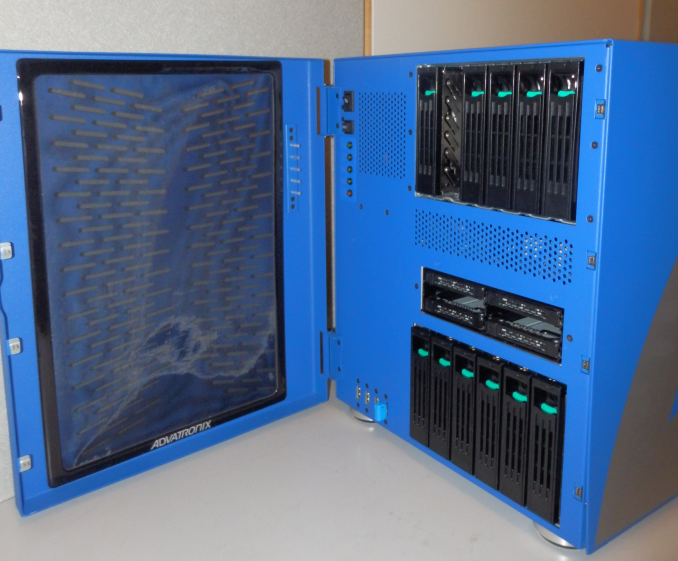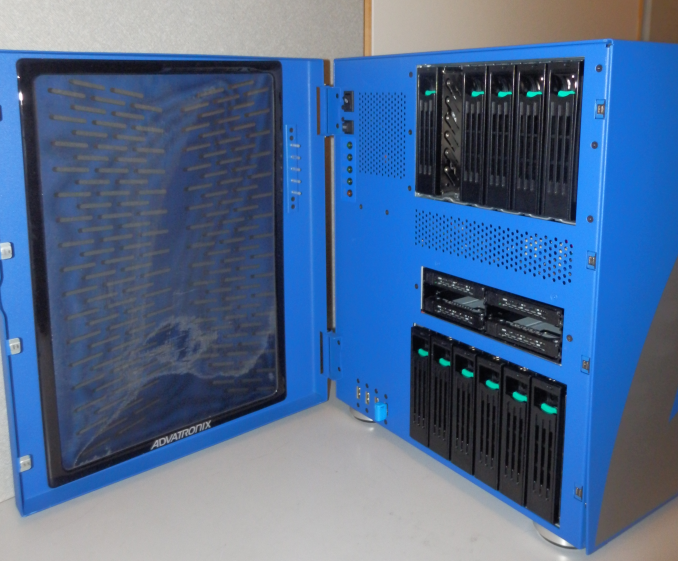Advatronix Cirrus 1200: a Storage Server Under Your Desk
by Johan De Gelas on June 6, 2014 5:00 AM EST
Almost every small company out there needs a minimum level of IT services: file serving, document management, e-mail, and so on. Most of those services can now be found in the Cloud: Google Apps Professional, Microsoft Office 365, Dropbox, Amazon AWS, and many others can take care of nearly any IT service you can think off. Although trendy, cloud services are not without disadvantages.
One example related to our review today is that the latency involved in accessing data over the internet is much higher than on a LAN. While network latency of a well configured LAN is less than half a millisecond, the latency of accessing a cloud service is several tens of milliseconds. And although high bandwidth Internet access has become a lot cheaper over the years, a 100 mbit/s or better is still not widespread among smaller companies, where a 1Gbps LAN is easily attainable. Moreover, while renting a few Terrabytes in the cloud has become relatively affordable, you again run into speed issues, especially if you have massive amounts of data that you want to analyze -- or if you simply feel that a third party should have no control over your (sensitive) data.
So if you require high bandwidth file serving and low latency database access, or if you need massive amounts of storage capacity, a local server could still be the attractive option. Of course, as a small company you likely don't have nor want a dedicated data center (or even just a smaller data room). A decent data room can be an expensive investment (e.g. it would need CRAC and other facilities) and the energy cost can be very high. Due to the costs, some might be tempted to use what others would consider an old fashioned twentieth century option: a server somewhere on a shelf or under a desk. But there are some 21st century requirements that are needed, so a noisy, power hungry tower server is out of the question. Density isn't generally an issue, but it would be great if the server is able to cool it's components in an office environment without being louder than the ambient office noise -- local whirlwinds are generally frowned upon.
The desire for a quiet, low energy server underneath your desk can still make sense: you are in control of your data, the capex investment is limited, and with a little help from a good service provider, it is workable even for those who don’t have an IT department. Sometimes, old and tried methods beat the newest hype. Advatronix felt that it could do better than the current tower server offerings and designed a proprietary chassis that resembles a cube shaped desktop.
The reason behind this rather bulky chassis with 18 (!) drivebays is that most companies that need an in-house server usually have high storage demands: they need low latency, high capacity, or both. Thus there must be enough room for plenty of magnetic disks and some space for an SSD caching tier. And of course, a large chassis also allows large fans and thus relatively quiet operation. In a nutshell, Advatronix feels the Cirrus 1200 sets itself apart from the competition for the following reasons:
- Quiet (enough) operation
- Low Power, able to keep to cool in an office environment (no need for a CRAC)
- Magnetic filter to cope with the fact that this server will be in dusty office instead of a clean data center
- A good mix of components with a focus on storage performance
As the IT services of small companies are typically bottlenecked by storage and not by CPU performance, the Cirrus 1200 uses a low power quad-core Xeon E3 with up to 32GB of RAM. It's certainly nothing earth shattering, but the combination of all points mentioned above might make the Cirrrus 1200 very attractive for a certain market niche.











39 Comments
View All Comments
Kevin G - Friday, June 6, 2014 - link
It really comes down to scale. A single system, regardless if it is a 4U server or a gaming rig can be run in a home environment and not have to worry too much about cooling. Sure, putting them in a closet with the door closet will cause them to bake but that'd be true of any high power piece of electronics.For a single server, a CRAC is overkill. When dealing with a room with hundreds of racks, each full of servers, a CRAC is necessary to deal with the heat output. CRAC's are also designed with datacenter RAS methodology. They're highly modular to ease service, typically fit into standard rack row and have monitoring capabilities. Multiple CRAC's can also load balance the cooling needs of a room or act has a 'hot spare' in case another unit fails. These are features you don't find in home air conditioning units.
There is also another thing to factor in comparing a gaming rig with server: size. Common servers are either 1U or 2U in height which means they'll use small high RPM fans internally. This means they're loud and there are a lot of them. Cooling for rack servers is done in one direction: front to back. A gaming rig tends to have plenty of room. Larger, lower RPM fans *can* move more air than several smaller 80 mm fans. In addition, the typical gamer case has more area to draw into it as well as for exhaust. In otherwords, a gaming case is less restrict in terms of airflow for cooling.
sciencegey - Saturday, June 7, 2014 - link
It isn't to do with power draw, it's the fact that your PC isn't running 24/7 with loads of HDDs (which create a lot of heat) and the fact that they will be running at around about 60% load constantly. Also, CRAC is just a fancy way of saying air conditioning.Ratman6161 - Friday, June 6, 2014 - link
Ummmmm. If your business relies on this data then it shouldn't be "under your desk".And don't forget your UPS and your offsite backups either. Another issue I see is that a company of a size that might be looking at something like this probably doesn't have any IT support in house to manage those backups and disaster recovery procedures. Unfortunately that's just the sort of situation where I find businesses doing this sort of thing. An amateur sets something up "under his desk" but when it fails they are screwed. Or when that person leaves the company they are screwed.
So there are probably certain niches where this sort of system could be useful but if a company doesn't either have IT staff or at least a support contract to manage things, it's very likely they would be better off in the cloud - if only for disaster recovery purposes.
Gunbuster - Friday, June 6, 2014 - link
The Dell T620 has a chassis option for 32 2.5" Hard Drivesvalinor89 - Friday, June 6, 2014 - link
"Moreover, while renting a few Terrabytes in the cloud has become relatively affordable..."Terrabytes is meant as a joke or a typo? It sounds cool anyway.
rpg1966 - Friday, June 6, 2014 - link
Terrabytes!https://d2kxqxnk1i5o9a.cloudfront.net/uploads/pict...
thunderbird32 - Friday, June 6, 2014 - link
Fujitsu is a weird company. I've never been able to find a reseller that carries their x86 servers or workstations. One wonders how much business they do in that category in the US.JohanAnandtech - Tuesday, June 10, 2014 - link
Thanks for sharing. Each time I went to Cebit, the people at Fujitsu had little interest talking to me, as I was international press. It is like the x86 line is their just to complete their product portfolio.Drizzt321 - Friday, June 6, 2014 - link
I would have liked to have seen an option to ditch the RAID cards and move to simple HBA cards to allow OS management of the arrays. Would also probably decrease the cost by a good bit.sciencegey - Saturday, June 7, 2014 - link
This thing seems kinda pointless because if you are a small business, you can get a cheap server rack and then get a storage server and even have places to put your network switch and VoIP box. This means you won't have to take up precious office space (you can mount server racks on walls) with this giant blue box. If you are really too cheap for a server rack-mount system, then you would probably just build your own file server, which is pretty easy (if you love Linux, make you own distro, use current distros like FreeNAS or shell out to get Windows Server. And if you are using Macs, then you just use a Time Machine/hackintosh as a Time Machine).